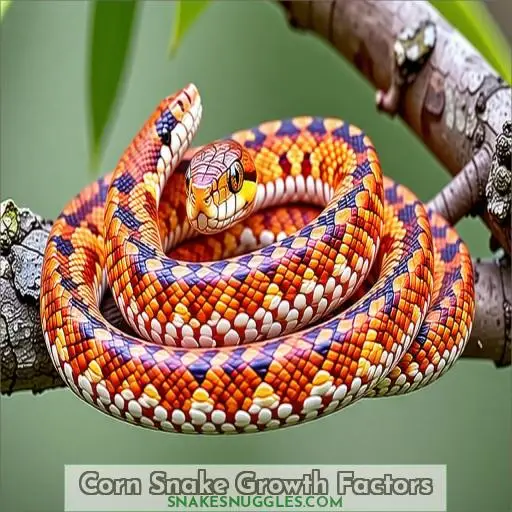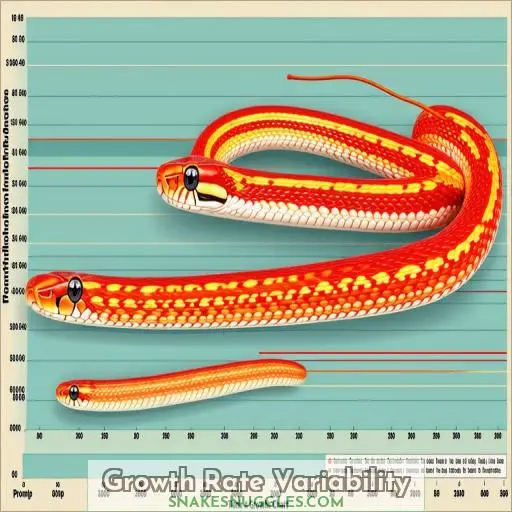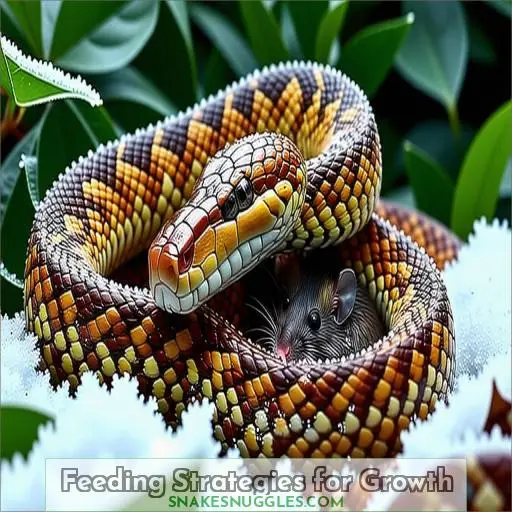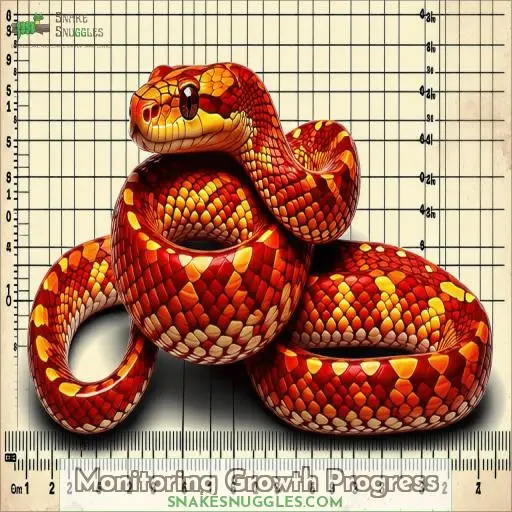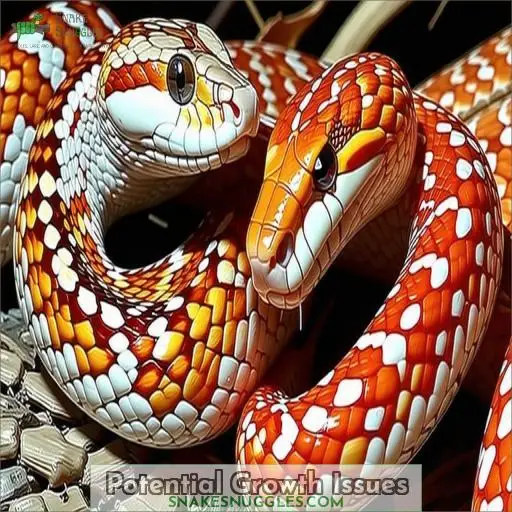This site is supported by our readers. We may earn a commission, at no cost to you, if you purchase through links.
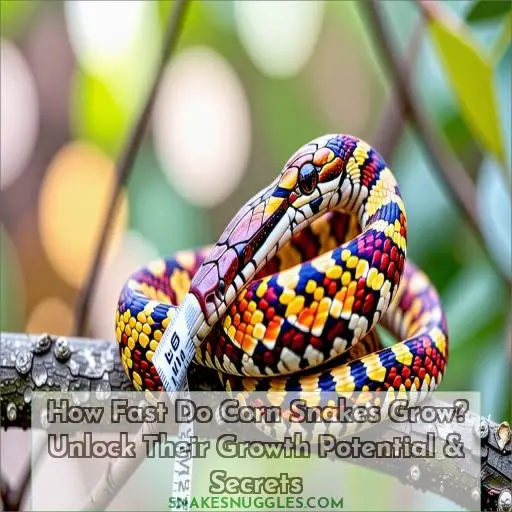 The growth rate of corn snakes can vary. Genetics lay the foundation, with potential size influenced by selective breeding. Even siblings can have different growth rates due to individual factors.
The growth rate of corn snakes can vary. Genetics lay the foundation, with potential size influenced by selective breeding. Even siblings can have different growth rates due to individual factors.
A balanced diet with proper feeding frequency is essential. Feed corn snakes every 5-7 days with appropriately sized prey.
The impact of a stress-free environment and ideal temperatures should not be underestimated. With diligent monitoring and care, you can maximize your corn snake’s growth potential.
There is more to explore about enhancing the growth of corn snakes if you would like to investigate further.
Table Of Contents
- Key Takeaways
- How Fast Do Corn Snakes Grow?
- Corn Snake Growth Factors
- Growth Rate Variability
- Feeding Strategies for Growth
- Monitoring Growth Progress
- Potential Growth Issues
- Frequently Asked Questions (FAQs)
- Why is my 2 year old corn snake so small?
- How to make a corn snake grow faster?
- How long does it take for a corn snake to be full grown?
- How big are corn snakes at 1 year old?
- What is the average lifespan of a corn snake?
- How do I determine the sex of my corn snake?
- What are the common color morphs of corn snakes?
- Can corn snakes be housed together safely?
- How often should I handle a growing corn snake?
- Conclusion
Key Takeaways
- Genetics play a pivotal role in determining a corn snake’s growth potential, influencing both size and growth rate variations among siblings.
- A balanced diet with appropriate feeding frequency, suitable prey sizes, and dietary variety is crucial for healthy growth and development.
- Proper husbandry practices, a low-stress environment, enrichment activities, and appropriate brumation periods collectively contribute to the overall well-being and growth potential of corn snakes.
- Regular monitoring, accurate measuring techniques, and seeking expert advice for potential growth concerns are essential for ensuring optimal growth and addressing any issues promptly.
How Fast Do Corn Snakes Grow?
Corn snakes grow at varying rates determined by genetics, diet, and health factors. Regular monitoring and appropriate feeding are key to ensuring healthy growth.
Corn Snake Growth Factors
A corn snake’s growth rate hinges on its genetic makeup, which determines its overall growth potential. A suitable diet, nutrition, and proper husbandry practices that support healthy development are significant factors influencing how rapidly a corn snake can attain its full size.
Genetics and Growth Potential
Genetics play a pivotal role in determining a corn snake’s growth potential. Selective breeding has produced fascinating color morphs, but also influences size. While some snakes may reach impressive lengths, others face hereditary size limitations. Understanding these genetic variations is key to revealing each corn snake’s unique growth trajectory.
Diet and Nutrition
Feeding your corn snake the right prey sizes and frequency is essential for healthy growth. Offer a varied diet with appropriate supplements to meet their nutritional needs. More frequent feedings (every 5-7 days) can promote faster growth, but avoid overfeeding. A diet rich in whole animal prey, such as mice and rats, which are approximately 1.5 times the width of the snake’s midsection, mimics natural feeding patterns supports your corn snake’s development.
Health and Husbandry Practices
When considering the health and husbandry practices for ideal corn snake growth, focus on:
- Proper enclosure setup
- Quarantine and acclimation
- Handling techniques
- Shedding support
- Enrichment and exercise.
Growth Rate Variability
Corn snakes exhibit substantial individual variability in their growth rates, even among siblings from the same clutch. You must understand that consistent feeding, appropriate prey sizing, a balanced diet with supplements, and proper husbandry are vital factors influencing healthy growth in these reptiles.
Individual Growth Rates
Even siblings from the same clutch can exhibit vastly different growth rates due to genetics. While some corn snakes may gain over 100 grams in their first year, others take several years to reach breeding size.
Gender also plays a role, with females generally growing larger than males. Age is another factor, as growth rate slows as snakes approach adulthood.
Monitoring your snake’s progress through regular weighing and measuring will help you understand its unique growth trajectory.
Crucial Factors for Healthy Growth
To ensure healthy growth in corn snakes, several crucial factors play a pivotal role.
- Maintaining a low-stress environment
- Providing enrichment activities
- Allowing for appropriate brumation periods
- Handling the snake gently
- Ensuring suitable lighting
These factors collectively contribute to the overall well-being and growth potential of corn snakes. Stress, in particular, should be minimized by providing a secure and enriching habitat, while appropriate lighting and handling practices also significantly impact the snake’s growth and development .
Feeding Strategies for Growth
To optimize growth, you need to strategically manage your corn snake’s feeding regimen. Feeding frequency directly impacts growth rate, with more frequent meals (every 5-7 days) promoting faster growth—though be cautious of overfeeding. Additionally, offering appropriately sized prey and a varied, well-supplemented diet provides essential nutrients for healthy development.
Feeding Frequency Impact
When optimizing your corn snake’s feeding schedule, consider the impact on its growth rate. Maintain a balanced approach to prevent overfeeding. 1. Schedule Regular Feedings 2. Avoid Power Feeding 3. Monitor Weight Changes 4. Seek Expert Guidance for Growth Optimization
Prey Size Considerations
Selecting the appropriate prey size is essential for your corn snake’s growth. Prey that’s too large can cause swallowing difficulties and even regurgitation, risking nutritional value. Compare the prey size to your snake’s body – it should be no more than 15-20% of its width. Opt for live or prekilled rodents for ideal growth.
Diet Variety and Supplementation
Supplement your corn snake’s diet with calcium and vitamin D3 to support strong bones and overall health. Offer a variety of appropriately sized prey like mice, rats, and gerbils to provide nutritional balance. Rotate prey types for dietary enrichment and to prevent nutritional deficiencies. A balanced diet is key to realizing your corn snake’s growth potential.
Monitoring Growth Progress
To accurately track a corn snake’s growth, it’s essential to monitor its size regularly. While growth rates vary, reaching sexual maturity around 2-3 years old, measuring the snake’s length and weight periodically provides valuable insights into its development and helps identify potential issues that may require adjustments or veterinary attention.
Size Estimates and Maturity
To monitor a corn snake’s growth and estimate its maturity, regularly measure its length and weight. Use a flexible measuring tape to obtain accurate length measurements, tracking the snake’s progress against established growth charts. Females typically reach larger sizes, but sexual maturity is usually achieved between 2-3 years of age. Evaluating size comparisons and observing growth spurts are essential for appraising the snake’s development.
| Monitoring Growth Progress | Using Growth Charts | Size Comparisons |
|---|---|---|
| Regular Measurement | Accurate Length | Female vs. Male |
| Weight Tracking | Growth Chart Tracking | Growth Spurts |
| Sexual Maturity Estimate | Breeding Size |
Slowdown in Growth Rate
As corn snakes approach adulthood, their growth rate naturally slows down. This gradual tapering off typically occurs around 3-4 years of age, as the snake shifts its focus from length to weight gain. Monitoring size and maturity is essential, as it can impact breeding plans and overall snake health. Shedding frequency also decreases during this stage.
Importance of Regular Measurements
To guarantee proper growth, utilize precise Measuring Techniques for tracking Growth Progress and Weight Monitoring. Regular measurements help assess Accelerated Growth and determine Growth Potential. Monitoring size and weight aids in evaluating development and adjusting care as needed for ideal health and growth.
Potential Growth Issues
Parasites can hinder a corn snake’s growth by competing for nutrients and causing health issues, so regular deworming and veterinary check-ups are vital. Improper temperature gradients or nutritional deficiencies can also lead to stunted growth, making it essential to provide an ideal thermal environment and a well-balanced diet fortified with appropriate supplements.
Parasites and Growth
Parasites can hinder a corn snake’s growth by competing for essential nutrients. Watch for signs like lethargy, poor appetite, and weight loss. Consult a vet to identify and treat any parasitic infections promptly for healthy growth.
Temperature Management
Proper temperature gradient creation, with a basking surface of 85-90°F and cool end of 75-80°F, is essential for healthy growth. Nighttime drops and seasonal changes mimic natural cycles. Use reliable measuring tools to monitor temperatures.
Nutritional Deficiencies
Nutritional deficiencies, like calcium, vitamin, or mineral deficiencies, can hinder a corn snake’s growth. Maintain a balanced diet with appropriate supplementation to support healthy development and prevent stunted growth.
Seeking Expert Advice for Growth Concerns
When addressing potential growth concerns in your corn snake, consult experienced breeders or reptile veterinarians. This can help in troubleshooting growth plateaus, addressing underlying health conditions, and monitoring the overall health of your snake.
Frequently Asked Questions (FAQs)
Why is my 2 year old corn snake so small?
Picture a tiny snake coiled around your pinky. That’s likely your corn snake – smaller than expected due to genetics, improper habitat, or a picky eater. With patience and proper care, it’ll surely grow into a slithery companion you’ll adore.
How to make a corn snake grow faster?
You can’t force faster growth, but providing ideal care – proper heating, humidity, varied diet, and avoiding stress – will support your corn snake’s healthy growth rate. Be patient, as pushing faster growth risks health issues.
How long does it take for a corn snake to be full grown?
Notably, corn snakes never stop growing! Most reach full size around 3-4 years old, but can continue gaining weight their entire lives. With proper care, you’ll have a lively, full-grown corn snake in just a few short years.
How big are corn snakes at 1 year old?
At 1 year old, you can expect your corn snake to be around 2-3 feet long, depending on its genetics and feeding regimen. Proper husbandry is key for ideal growth.
What is the average lifespan of a corn snake?
Corn snakes live an average of 15-20 years with proper care. However, some individuals can exceed 25 years with excellent husbandry practices.
How do I determine the sex of my corn snake?
You may think size says it all, but nope! Probing by an expert is the reliable way to determine a corn snake’s sex. While certain behaviors hint at gender, size alone doesn’t give you the full scoop.
What are the common color morphs of corn snakes?
Some common corn snake color morphs include: amelanistic (albino), anery (black), caramel, candy cane, ghost, plasma, and more. Morphs exhibit distinct patterns and hues through selective breeding.
Can corn snakes be housed together safely?
No, you shouldn’t house corn snakes together. They’re solitary and may fight or cannibalize each other if cohabitated.
How often should I handle a growing corn snake?
Handle young corn snakes infrequently—weekly at most. Too much handling can stress them and stunt growth. As they mature, you can handle them more often but start slow.
Conclusion
Ultimately, how fast do corn snakes grow depends on multiple factors you can optimize. By understanding their genetic potential, providing a nutritious diet with proper feeding intervals, and maintaining ideal husbandry conditions, you’ll realize their maximum growth rate. Regularly monitoring and adjusting these elements guarantees your corn snake thrives and reaches its full size potential.

